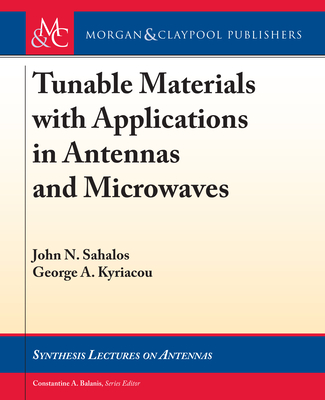Finite Antenna Arrays and FSS
暫譯: 有限天線陣列與頻率選擇表面
Ben A. Munk
- 出版商: Wiley
- 出版日期: 2003-07-22
- 售價: $8,510
- 貴賓價: 9.5 折 $8,085
- 語言: 英文
- 頁數: 392
- 裝訂: Hardcover
- ISBN: 0471273058
- ISBN-13: 9780471273059
已絕版
買這商品的人也買了...
-
 C++ 教學範本 (Beginning C++: The Complete Language )
C++ 教學範本 (Beginning C++: The Complete Language )$680$537 -
 軟體專案管理(平裝版)
軟體專案管理(平裝版)$600$540 -
 專業 XML 程式設計第二版 (Professional XML, 2/e)
專業 XML 程式設計第二版 (Professional XML, 2/e)$800$632 -
 PostgreSQL 實務應用
PostgreSQL 實務應用$420$328 -
 重構─改善既有程式的設計
重構─改善既有程式的設計$720$569 -
 An Introduction to Management Science: Quantitative Approaches to Decision Making, 10/e
An Introduction to Management Science: Quantitative Approaches to Decision Making, 10/e$1,080$1,058 -
 Windows CE 嵌入式系統理論與實務
Windows CE 嵌入式系統理論與實務$680$537 -
 Visual Basic 6 範例教本, 2/e
Visual Basic 6 範例教本, 2/e$430$409 -
 現代專案管理教材
現代專案管理教材$580$452 -
 Head First Servlets & JSP
Head First Servlets & JSP$1,980$1,881 -
 Introduction to Operations Research, 8/e
Introduction to Operations Research, 8/e$1,080$1,058 -
 ASP.NET 徹底研究進階技巧─高階技巧與控制項實作
ASP.NET 徹底研究進階技巧─高階技巧與控制項實作$650$507 -
 Matlab 7.X 程式開發與應用技巧
Matlab 7.X 程式開發與應用技巧$650$514 -
 數值方法─工程上的應用 (Numerical Method for Engineers: With Software and Programming, 4/e)
數值方法─工程上的應用 (Numerical Method for Engineers: With Software and Programming, 4/e)$720$706 -
 Linux iptables 技術實務─防火牆、頻寬管理、連線管制
Linux iptables 技術實務─防火牆、頻寬管理、連線管制$620$490 -
 FrontPage 2003: The Missing Manual
FrontPage 2003: The Missing Manual$1,210$1,150 -
 Phased Array Antennas: Floquet Analysis, Synthesis, BFNs and Active Array Systems
Phased Array Antennas: Floquet Analysis, Synthesis, BFNs and Active Array Systems$7,320$6,954 -
 突破 Word 2007 中文版
突破 Word 2007 中文版$350$298 -
 免費!合法!超 Easy OpenOffice.org2
免費!合法!超 Easy OpenOffice.org2$350$277 -
 輕鬆打造我的網站─XOOPS2 深入使用手冊
輕鬆打造我的網站─XOOPS2 深入使用手冊$580$493 -
 深入淺出物件導向分析與設計 (Head First Object-Oriented Analysis and Design)
深入淺出物件導向分析與設計 (Head First Object-Oriented Analysis and Design)$880$695 -
 Electromagnetic Theory (Hardcover)
Electromagnetic Theory (Hardcover)$5,820$5,529 -
 深入淺出軟體開發 (Head First Software Development)
深入淺出軟體開發 (Head First Software Development)$680$537 -
 程式之美-微軟技術面試心得
程式之美-微軟技術面試心得$490$387 -
 聖殿祭司的 ASP.NET 3.5 專家技術手冊 II 新功能篇-使用 C#
聖殿祭司的 ASP.NET 3.5 專家技術手冊 II 新功能篇-使用 C#$740$585
商品描述
Description:
A periodic surface is an assembly of identical elements arranged in a one or two-dimensional array. Such surfaces have various effects on incident electromagnetic waves. Their applications range from antennas to stealth aircraft.This book discusses finite antenna arrays and how to minimize the radar cross section of these arrays.
"Ben has been the world-wide guru of this technology...Ben Munk has written a book that represents the epitomy of practical understanding." W. Bahret, United States Air Force
Frequency selective surfaces (FSSs) have important military and civilian applications including antenna theory, satellite communications and stealth technology
Author is an authory on the subject, having been instrumental in the development of stealth technology for the US Air Force
Much of the material in this book was deemed classified due to its importance to defence
Table of Contents:
Foreword.
Preface.
Acknowledgments.
Symbols and Definitions.
1. Introduction.
1.1 Why Consider Finite Arrays?
1.2 Surface Waves Unique to Finite Periodic Structures.
1.3 Effects of Surface Waves.
1.4 How Do We Control the Surface Waves?
1.5 Common Misconceptions.
1.6 Conclusion.
1.7 Problems.
2. On the RCS of Arrays.
2.1 Introduction.
2.2 Fundamentals of Antenna RCS.
2.3 How to Obtain a Low σtot by Cancellation (Not Recommended).
2.4 How Do We Obtain Low σtot Over a Broad Band?
2.5 A Little History.
2.6 On the RCS of Arrays.
2.7 An Alternative Approach: The Equivalent Circuit.
2.8 On the Radiation from Infinite vs. Finite Arrays.
2.9 On Transmitting, Receiving and Scattering Radiation Pattern of Finite Arrays.
2.10 Minimum versus Non-Minimum Scattering Antennas.
2.11 Other Non-Minimum Scattering Antennas.
2.12. How to Prevent Coupling Between the Elements Through the Feed Network.
2.12 How to Eliminate Backscatter Due to Tapered Aperture Illumination.
2.13 Common Misconceptions.
2.15 Summary.
2.16 Problems.
3. Theory.
3.1 Introduction.
3.2 The Vector Potential and the H-Field for Column Arrays of Hertzian Elements.
3.3 Case I: Longitudinal Elements.
3.4 Case II: Transverse Elements.
3.5 Discussion.
3.6 Determination of the Element Currents.
3.7 The Double Infinite Arrays with Arbitrary Element Orientation.
3.8 Conclusions.
3.9 Problems.
4. Surface on Passive Surfaces of Finite Extent.
4.1 Introduction.
4.2 Model.
4.3 The Infinite Array Case.
4.4 The Finite Array Case Excited by Generators.
4.5 The Element Currents on a Finite Array Excited by an Incident Wave.
4.6 How the Surface Waves are Excited on a Finite Array.
4.7 How to Obtain the Actual Current Components.
4.8 The Bistatic Scattered Field from a Finite Array.
4.9 Parametric Study.
4.10 How to Control Surface Waves.
4.11 Finite Tuning the Load Resistors at a Single Frequency.
4.12 Variation with Angle of Incidence.
4.13 The Bistatic Scattered Field.
4.14 Previous Work.
4.15 On Scattering from Faceted Radomes.
4.16 Effects of Discontinuities in the Panels.
4.17 Scanning in the E-plane.
4.18 Effect of a Groundplane.
4.19 Common Misconceptions Concerning Element Currents on Finite Arrays.
4.20 Conclusion.
4.21 Problems.
5. Finite Active Arrays.
5.1 Introduction.
5.2 Modeling of a Finite x Infinite Groundplane.
5.3 Finite x Infinite Array with an FSS Groundplane.
5.4 Micro Management of the Backscattered Field.
5.5 The Model for Studying Surface Waves.
5.6 Controlling Surface Waves on Finite FSS Groundplanes.
5.7 Controlling Surface Waves on Finite Arrays of Active Elements with FSS Groundplane.
5.8 The Backscatterd Fields from the Triads in a Large Array.
5.9 On the Bistatic Scattered Field from a Large Array.
5.10 Further Reduction: Broadband Matching.
5.11 Common Misconceptions.
5.12 Conclusion.
5.13 Problems.
6. Broadband Wire Arrays.
6.1 Introduction.
6.2 The Equivalent Circuit.
6.3 An Array with Groundplane and No Dielectric.
6.4 Practical Layouts of Closely Spaced Dipole Arrays.
6.5 Combination of the Impedance Components.
6.6 How to Obtain Grater Braodwidth.
6.7 Array with a Groundplane and a Single Dielectric Slab.
6.8 Actual Calculated Case: Array with Groundplane and Single Dielectric Slab.
6.9 Array with Groundplane and Two Dielectric Slab.
6.10 Comparison Between the Single and Double Slab Array.
6.11 Calculated Scan Impedance for Array with Groundplane and Two Dielectric Slabs.
6.12 Common Misconceptions.
6.13 Conclusions.
7. An Omnidirectional Antenna with Low RCS.
7.1 Introduction.
7.2 The Concept.
7.3 How Do We Feed the Elements?
7.4 Calculated Scattering Pattern for Omnidirectional Antenna with Low RCS.
7.5 Measured Backscatter from a Low RCS Omnidirectional Antenna.
7.6 Common Misconceptions.
7.7 Conclusions and Recommendations.
8. The RCS of Two-Dimensional Parabolic Antennas.
8.1 The Major Scattering Components.
8.2 Total Scattering from a Parabolic Reflector with a Typical Feed.
8.3 Practical Execution of the Low RCS Feed.
8.4 Out of Band Reduction.
8.5 Common Misconceptions on Edge Currents.
8.6 Conclusion.
9. Aperiodicity: Is it a Good Idea?
9.1 Introduction.
9.2 General Analysis of Periodic Structures with Perturbation of Element Loads and/or Inter-element Spacings.
9.3 Perturbation of Arrays of Tripoles.
9.4 Making Use of Our Observations.
9.5 Anomalies due to Insufficient Number of Models.
9.6 Aperiodicity on Finite Arrays.
9.7 Conclusions.
10. Summary and Final Remarks.
10.1 Summary.
10.2 Are We Going in the Right Direction?
10.3 Let Use Make Up!
Appendix A. Determination of Transformation and Position Circles.
Appendix B. Broadband Matching.
Appendix C. Meander-Line Polarizers for Oblique Incidence.
Appendix D. On the Scan versus the Embedded Impedance.
References.
Index.
商品描述(中文翻譯)
描述:
一個週期性表面是由相同元素組成的,這些元素以一維或二維的陣列排列。這類表面對入射的電磁波有各種影響。它們的應用範圍從天線到隱形飛機。本書討論有限天線陣列及如何最小化這些陣列的雷達截面。
「Ben 是這項技術的全球權威……Ben Munk 寫了一本書,代表了實用理解的典範。」— W. Bahret,美國空軍
頻率選擇表面(FSS)在軍事和民用領域有重要應用,包括天線理論、衛星通信和隱形技術。
作者在這一領域是權威,對美國空軍的隱形技術發展起到了重要作用。
本書中的許多材料因其對國防的重要性而被認為是機密的。
目錄:
前言。
序言。
致謝。
符號與定義。
1. 介紹。
1.1 為什麼考慮有限陣列?
1.2 獨特於有限週期結構的表面波。
1.3 表面波的影響。
1.4 我們如何控制表面波?
1.5 常見誤解。
1.6 結論。
1.7 問題。
2. 陣列的 RCS。
2.1 介紹。
2.2 天線 RCS 的基本原理。
2.3 如何通過抵消獲得低 σtot(不建議)。
2.4 我們如何在寬頻上獲得低 σtot?
2.5 一點歷史。
2.6 陣列的 RCS。
2.7 替代方法:等效電路。
2.8 無限與有限陣列的輻射。
2.9 有關有限陣列的發射、接收和散射輻射模式。
2.10 最小與非最小散射天線。
2.11 其他非最小散射天線。
2.12 如何通過供電網絡防止元素之間的耦合。
2.12 如何消除由於錐形孔徑照明引起的回散射。
2.13 常見誤解。
2.15 總結。
2.16 問題。
3. 理論。
3.1 介紹。
3.2 赫茲元件柱陣列的矢量勢和 H 場。
3.3 案例 I:縱向元件。
3.4 案例 II:橫向元件。
3.5 討論。
3.6 元件電流的確定。
3.7 任意元件方向的雙無限陣列。
3.8 結論。
3.9 問題。
4. 有限範圍被動表面上的表面。
4.1 介紹。
4.2 模型。
4.3 無限陣列情況。
4.4 由發生器激發的有限陣列情況。
4.5 由入射波激發的有限陣列上的元件電流。
4.6 如何在有限陣列上激發表面波。
4.7 如何獲得實際電流分量。
4.8 來自有限陣列的雙靜態散射場。
4.9 參數研究。
4.10 如何控制表面波。
4.11 在單一頻率下有限調整負載電阻。
4.12 隨入射角的變化。
4.13 雙靜態散射場。
4.14 先前的工作。
4.15 有關多面體雷達罩的散射。
4.16 面板中不連續性的影響。
4.17 在 E 平面上的掃描。
4.18 地面平面的影響。
4.19 有關有限陣列上元件電流的常見誤解。
4.20 結論。
4.21 問題。
5. 有限主動陣列。
5.1 介紹。
5.2 有限 x 無限地面平面的建模。
5.3 帶有 FSS 地面平面的有限 x 無限陣列。
5.4 回散射場的微觀管理。
5.5 研究表面波的模型。
5.6 控制有限 FSS 地面平面上的表面波。
5.7 控制帶有 FSS 地面平面的主動元件有限陣列上的表面波。
5.8 大陣列中三元組的回散射場。
5.9 大陣列的雙靜態散射場。
5.10 進一步減少:寬頻匹配。
5.11 常見誤解。
5.12 結論。
5.13 問題。
6. 寬頻導線陣列。
6.1 介紹。
6.2 等效電路。
6.3 帶有地面平面且無介電材料的陣列。
6.4 緊密間隔偶極子陣列的實用佈局。
6.5 阻抗分量的組合。
6.6 如何獲得更大的帶寬。
6.7 帶有地面平面和單一介電板的陣列。
6.8 實際計算案例:帶有地面平面和單一介電板的陣列。
6.9 帶有地面平面和兩個介電板的陣列。
6.10 單板和雙板陣列之間的比較。
6.11 帶有地面平面和兩個介電板的陣列的計算掃描阻抗。
6.12 常見誤解。
6.13 結論。
7. 低 RCS 的全向天線。
7.1 介紹。
7.2 概念。
7.3 我們如何為元件供電?
7.4 低 RCS 全向天線的計算散射模式。
7.5 低 RCS 全向天線的測量回散射。
7.6 常見誤解。
7.7 結論與建議。
8. 二維拋物面天線的 RCS。
8.1 主要散射分量。
8.2 帶有典型供電的拋物面反射器的總散射。
8.3 低 RCS 供電的實際執行。
8.4 帶外減少。
8.5 有關邊緣電流的常見誤解。
8.6 結論。
9. 非週期性:這是一個好主意嗎?
9.1 介紹。
9.2 具有元件負載和/或元件間距擾動的週期結構的一般分析。
9.3 三極子陣列的擾動。
9.4 利用我們的觀察。
9.5 由於模型數量不足而產生的異常。
9.6 有限陣列上的非週期性。
9.7 結論。
10. 總結與最終評語。
10.1 總結。
10.2 我們是否走在正確的方向?
10.3 讓我們和解!
附錄 A. 變換和位置圓的確定。
附錄 B. 寬頻匹配。
附錄 C. 用於斜入射的曲折線偏振器。
附錄 D. 有關掃描與嵌入阻抗的問題。
參考文獻。
索引。










